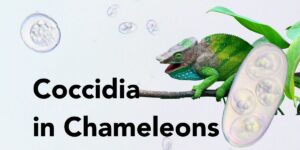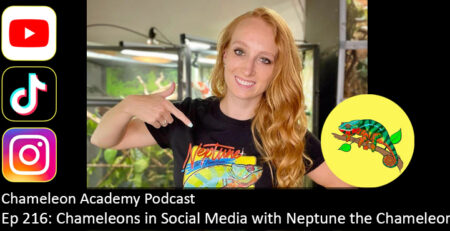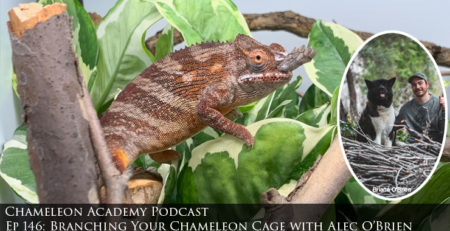Small Batch Breeding Discussion
There are two persistent problems in the chameleon community that may have a common solution. The problems I am referring to are the lack of chameleon species established in captivity and simple breeder burn out. I think the small batch breeding concept may be a viable answer.
Podcast Player
Introduction to Small Batch Breeding
There are two persistent problems in the chameleon community that may have a common solution. The problems I am referring to are the lack of chameleon species established in captivity and simple breeder burn out. I think the small batch breeding concept may be a viable answer.
What is Small Batch Breeding?
Small batch breeding is a concept where you deliberately limit the number of chameleons you keep as part of your breeding group so that you are able to give each one keeper level husbandry. This refers to the shift in husbandry that typically happens when keepers start breeding. When you are a keeper with a few chameleons, they get the big cages and the latest in equipment. When you increase your number of chameleons your husbandry slowly, or quickly drifts to the minimalistic side. This is where the cages become smaller to fit more chameleons in the same space. The insides of the cages become sparse and the design is more for being able to clean quickly rather than what would enrich the chameleon. This is often called “breeder care” because breeders must find ways of maintaining large numbers of chameleons in both space and maintenance time. And, this makes sense. You have a certain amount of time, space, and money for chameleons. That is spread across how many chameleons you have. The fewer the chameleons the better they are cared for. The point of small batch breeding is to stop expanding the number of chameleons when you have reached the limit to how many chameleons you can have while they are all getting top care.
The insidious creep of overwhelm
The most important aspect of small batch breeding is the most difficult. You need to stop expanding while you still have time, money, and energy! The universal thing that takes down chameleon or any other reptile keepers is when they expand to the point where the work has gone beyond the joy. The challenge is that the dopamine hit of getting a new reptile or completing a collection overshadows the eroding away of the day to day enjoyment you are getting. You start with one chameleon that has a huge cage, live plants, three types of hydration, a name, and a written record of when he poops, eats, and goes to the vet. Somehow you end up with a wall full of small sparse cages with group lighting, a sprig of plastic plant in each, and identifying numbers instead of names. Instead of relaxing with a coffee and watching your chameleon climb through his cage to the basking branch you are up late into the night cleaning cages or just will take care of it tomorrow or the weekend.
The details are different in every situation, but I hope I conveyed the overall feel that we go through when we decide we want to become a breeder. We love our time with our chameleon so much that we turn ourselves into a workhorse that no longer is spending that quality time with our chameleons Sure, we are spending lots of time, but we are working now instead of enjoying. And this is the recipe for breeder burnout.
The Challenges of Small Batch Breeding
It may sound simple, then, to limit your growth. It definitely takes self-control to not collect them all, especially today when captive hatched are readily available, but surely that is not impossible to do! And this is true when you are in Keeper mode. But once you decide to breed chameleons it actually takes work to limit how many chameleons you have. After years of researching and learning before getting your first chameleon we have not developed any skills to limit the number of chameleons we keep!
The biggest issue that makes small batch breeding difficult is that chameleons have such large clutches. Panthers can do 20 to 30 eggs and that is a lot of babies. Veileds should be in that range, but if you feed them too much it really isn’t hard to get 40 to 60 to over 100 eggs and then babies. So how can we chameleon breeding folk take advantage of the benefits of this technique when the first single clutch puts us way over? It is a very good question and one we are going to have to, as a community, put our heads together and figure out.
I can point out a couple of things we have to figure out to be small batch breeders. The first is to remove the thought of making money, turning a profit, and paying for itself. You see, even if there was a way to rehome all but five or six babies, something deep in us says, “wait a minute…these are worth money.” And so we start thinking that we should get something from the babies we are sending to new homes. You aren’t necessarily wrong for thinking that, but do you see how your enjoyment of the chameleon art was suddenly given a new partner called profit?
The problem when we combine our love for chameleons with the idea of profit is that certain efficiencies must be taken into account that has everything to do with space to house chameleons and nothing to do with how to best house chameleons. So we start figuring out what the minimum husbandry a chameleon needs to be healthy. At least at this point in our community, breeders have to do this. And that will be the case until we can figure out how to produce the number of babies needed to help the community grow. I know that sounds calculating and even a cold way of looking at breeding chameleons, but I have been involved with this community for many decades and I have seen how important it is for us to have the numbers to fight back against legislation against reptile keeping. I have seen how a growing reptile community has opened up the space for vets to specialize in exotic animals. And the further into mainstream we go the less fear there is with reptiles and the more appreciation there is for the natural world in general. As an individual making decisions about your own breeding project, you don’t have to worry about any of this right now, but, I think it is an easy statement to make that we need high quality breeders that can produce high quality chameleons to go to educated new keepers. We need the breeder infrastructure we have until it can be replaced with something better that is just as effective. That can take many possible forms and we will just have to see what the future holds. Could small batch breeding be a part of community evolution? It is possible, but there would have to be significant community adoption and cooperation for that to happen. Honestly, at this point, I would consider it a huge win for small batch breeding to be established for the purpose of keeping the joy in chameleon keeping even when you transition to try breeding. I would be ecstatic if small batch breeding could be implemented to establish a species of chameleon in captivity. And those of you who follow my weekly live session you know where I am going with that. Many of us are looking at experimenting with small batch breeding with Calumma oshaughnessyi, the Shamrock Chameleon.
The reason why I am talking about profit and why it is a hurdle to overcome to keep the joy in breeding is that you can maintain the same level of highest husbandry standards if you only keep five or six babies. Would we as a community be able to create a layer of trusted, experienced keepers that would take in the rest of the babies? And even if we as individuals could put our happiness over making money and we could find trusted, experienced keepers that are able to care for hatchlings, other questions arise. How quickly would we saturate that pool of experienced keepers. Would filling up all these experienced keepers then saturate the market, drive down the price, and doom any long term serious breeding projects just as effectively as having them be imported at low prices?
I have been trying to establish species for decades. The failure of this seems to always hinge on availability and price point. What would happen if we removed price from it? Is there a snowball’s chance of making breeding for fun a community phenomenon? I know in the carnivorous plant community, at least 20 years ago, people were more interested in trading than selling. It was a healthy enriching environment. I wonder if we could explore that within our chameleon community.
Breeder Burnout
So, what is the value of experimenting with new things like this? Well, we can avoid new breeder burnout. There is no way to save the beginning breeder who wants to make lots of money and gets eggs from ten of his female panthers. We all know where this ends up. And for those new to this, it ends up in complete disaster as this new breeder learns that the challenge is raising the babies, not getting the babies. But for our conversation I want to look at the keeper who has decided that they want to step to the next level of their growth and learn about breeding their chameleon. Raising a species through its entire lifecycle has immense value in your understanding of the species. Breeding is a natural step and, if you have the curiosity, I highly encourage you to take it. The complication is that there is no real middle step. You have two chameleons one day and then you have 30. The new breeder is either trying group raising which means they have to worry about bullying and whether each baby is eating or has stepped up to the plate and created a wall of cages to raise them individually. Both of those are less than an ideal situation. And this has the potential to burn people out.
I recently tried some individual raising in 16”x16”x30” cages. I had so much fun with them. I own the Dragon Strand chameleon caging company so I have a lot of cages around or available to me. And I do love having a wall of nursery cages. Lately I have been doing them up bioactive and get great joy from making these miniature environments. But, it was even better with one hatchling in the 16x16x30. I was able to spoil him with a fancy feeder run cup, two sizable schefflera umbrella plants, and even a bioactive substrate. I was able to sit back and enjoy this one growing up every day.
What I am imagining is that, in a small batch breeding set-up, you have large beautiful cages for the adults and keep five to six smaller, but still sizable cages for the babies you want to raise up. You hear from breeders that they would love to make beautiful cages for their babies, but they just can’t with the time it takes to maintain them. So, if you are a new breeder and you are doing this for enjoyment and enrichment, what is the maximum number of beautifully done, full featured cages you can fit in your space and spend time maintaining? That would be your limit! Imagine being able to breed your chameleon, experience all life stages, and all the while doing it with the best husbandry possible. If you do not have a financial requirement then jealously guard your level of satisfaction, pride, and experience. Because I will tell you straight up, you learn more from raising a hatchling in a full featured enclosure than you do raising 30 in a bin or in 30 minimalistic cages. That is for a commercial breeder to do. Don’t sacrifice your prime goals – education, experience, and enjoyment – if you are not intending to make this a financially driven venture.
This sounds great, but, as mentioned before, now requires a way to place the rest of the hatchlings with people who know what they are doing. And this requires having friends, colleagues, and a strong community built around this concept. And, I’d like to try this out. Small batch breeding is a regular topic on my weekly live sessions with a dedicated segment of the attendees. It has to be. Because I don’t have all the answers on this one. We need to work it out, try it out, and experiment with how we can make this structure viable. And I think it is worth it. The benefits of gaining breeding experience while still maintaining the highest level of husbandry are worth working for. I think this model is within reach. With just a little community support it is possible to find a network of people experienced enough and willing to accept hatching overflow. So, we are going to try it and see what happens.
The next step is a little more ambitious. Could we actually hold together a group of small batch breeders and work together to establish a species in captivity? There are a number of things to work out. And when you talk about it in terms of working with real world people with real world lives it does seem like it is a long shot to say anyone can work together long enough to make a difference. So, we come full circle to the question, where do we go from here? Do we accept that as long as wild caught chameleons are coming in we won’t be able to establish another species at a price point that will support a breeding community? Do we just accept that if it hasn’t happened naturally through the unassailable supply and demand model that it is not to be? Well, if you are a betting person that is probably the safest bet. It is inevitable that imports will stop. When it does we will be left with whatever we have built up in these many years of having easy access to species.
We have a short time that we are here on this pale blue dot lost in the cosmos ocean doing things with chameleons. If the end is inevitable, that when imports stop we will be left with panther chameleons and progressively more inbred Veileds, then that end will come regardless whether we sit and wait for it or if we try to change our stars. So, to the people who are so realistic that they see the hurdles, yes, I hear what you are saying and there is wisdom in what you say. I am a great fan of reality. But I am also a great fan of hitting for the bleachers. So, could we implement a new perspective to keeping our chameleons? Could we cooperate in a way that doesn’t revolve around money? Or will we slam into simple stubborn human nature and find we are our own worst enemies of success?
For those who don’t mind embarking on what could be a quixotic quest I know we can find some windmills to tilt. And to all of the wise people watching with a critical eye, who know that they are windmills we are charging, you are invited along as well. Every Quixote needs a Sancho who knows better, but wouldn’t miss it for the world. If you hang out on my live sessions you know we have a number of Quixote’s saddling up already so there are a lot of spaces open for people who want to come along for the ride.
Conclusion
This is the last episode in season 8 of the Chameleon Academy Podcast. We started this season, literally, in Madagascar and have strengthened our community along the way. I launched a digital magazine for chameleon lover, the Chameleon Academy Journal, and I turned this podcast feed into a network with the addition of the iPardalis podcast. A podcast about the mini chameleons from Dr. Michael Nash is coming soon. And I have just launched an exciting new line of Chameleon Academy enclosures in a collaboration with Paul Barclay and Custom Reptile Habitats. This new line of enclosures will help us further explore bioactive environments in the chameleon community as well as try out some of those small batch breeding concepts. But we will explore those topics in depth in season 9 which will start at the beginning of February 2024. Even though I take this time to refresh and plan for the next season, you will get plenty of content over the next two months with Jonathan and Michael. And I will continue my weekly live sessions at 5PM Pacific Tuesday nights on Instagram and 12 noon Pacific Saturday afternoons on YouTube. I even have chameleon chore night Sunday’s at 5PM pacific live on Instagram. It isn’t a show, Just me doing chameleon chores and I invite you to do those weekly chores at that time too and we can all talk shop!
So, from the bottom of my heart, I thank you for joining me on this adventure. Your support and company along the way makes this happen and makes this all a whole lot of fun! Have a great holiday season, and I will see you in season 9.













